Types and varieties of spruce
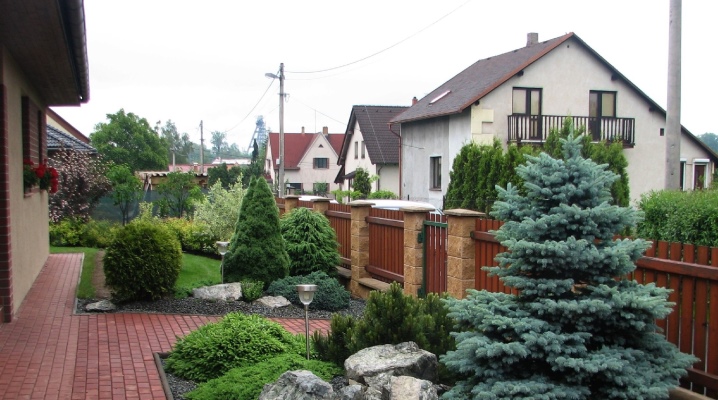
The variety of species and varieties of fir trees can be a big surprise for those gardeners who wish to decorate the landscape of their site with these evergreen conifers. European, Korean, Sitka and other tree species can differ dramatically in growth rate and appearance. There are weeping and erect subspecies, spherical and conical variants.

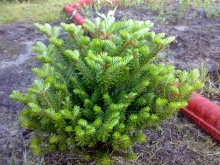

Among these conifers there are real giants and dwarfs that do not grow more than 1-2 m.
It is interesting to study in detail the spruce "Tompa", "Froburg", "Kupressiana" and other varieties with names both for educational purposes only and for a better understanding of the difference between plants. The choice of the place of their growth and the conditions of selection also have a huge impact on the appearance of trees. An exquisite decorative spruce can become a real decoration of an oriental garden. The blue one will ennoble the Central Russian landscape, and the rounded one will easily turn into a designer masterpiece in the bonsai style. You just need to take a fresh look at the possibilities of using the well-known tree.

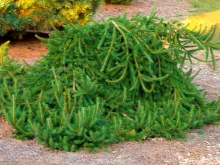

Description
Botanical Description of Spruce (Picea in Latin) indicates that this plant belongs to the coniferous variety of the Pine family. It grows in the mountains of China and the northern states of the United States, in Russia it is represented almost everywhere - from the Caucasus to the Far East, it can be found in Finland and Sweden, as well as in other countries of the world with fairly pronounced seasonal climatic changes.
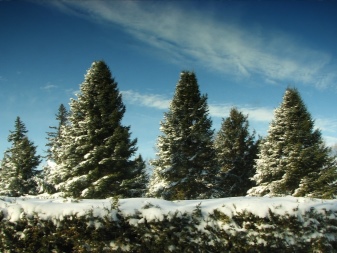
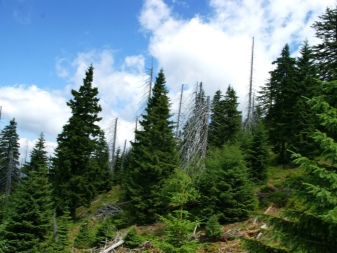
In total, there are about 40 different species, not counting hybrids. Spruce is characterized by a change in the root system as it grows. In the first 15 years of a tree's life, it has a pivotal character, then it changes to a superficial one. This allows the spruce to use root shoots as clones even after the death of the trunk - such processes can last for thousands of years.
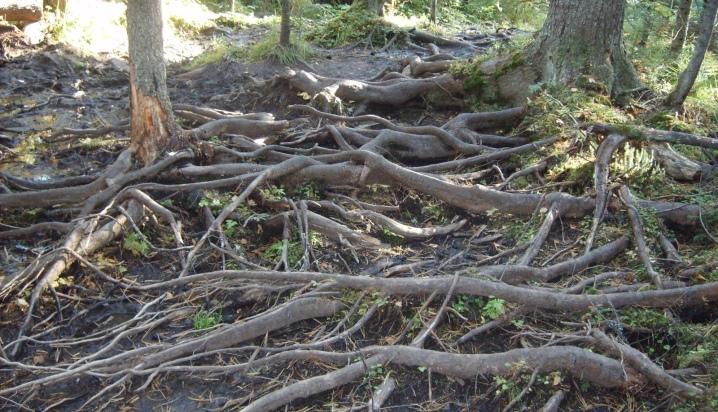
For example, the oldest officially recorded Picea abies tree in Sweden is 9,550 years old, given the age of all its branches and shoots.
Spruce is characterized by a pyramidal or cone-like crown shape. Branching type - whorled, shoots can be weeping (drooping) or outstretched in a horizontal plane. Lateral processes begin to appear from the 4th year of the tree's life. Spruce is characterized by the presence of a thin lamellar bark, its color varies from red-brown to gray. With age, it thickens, becomes coarser, pronounced furrows appear on the surface.

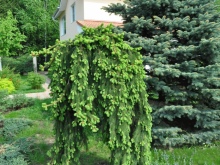
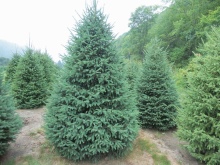
Like other trees of the pine family, spruce has acicular green needles on the branches instead of leaves, which have a flat or tetrahedral structure. They are located on branches in a spiral, renewal occurs every 6 years, and up to 15% of the total cover falls off during the year. Fruiting of fir trees with the formation of cones occurs in the 10-60 year of the tree's life, depending on the availability of favorable conditions for this.
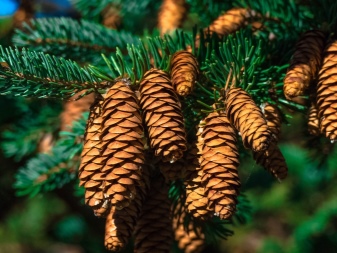
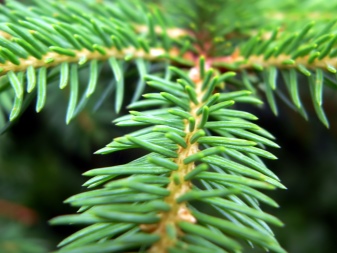
The average life span of a tree is 250-600 years, excluding clone shoots.
Variety of species
The variety of spruce species is so great that it can amaze a person who is far from botany. In total, there are 4 hybrid subtypes and 37 initial, natural origin. There is a mountain and steppe form of the tree, there are two-color and white variants. The most popular and famous ones are worth considering in more detail.
European or common
The most famous and widespread type of spruce with an extensive growing area. It is Picea abies that is considered aboriginal for the Central Russian territories and is best suited for local climatic conditions. In European countries, common spruce forms large tracts of forests, mainly in the north-east of the continent.

In Russia, it can be found both in the north and in the Black Earth Region, on the middle Volga.
European spruce is light-requiring, capable of growing in mixed and continuous forests, not afraid of drought, but sensitive to spring frosts. Trees rarely reach an age of over 120-300 years, it can be calculated by the number of parallel tiers of branches - 3-4 years are added to their number, in which the seedling forms the first shoots.
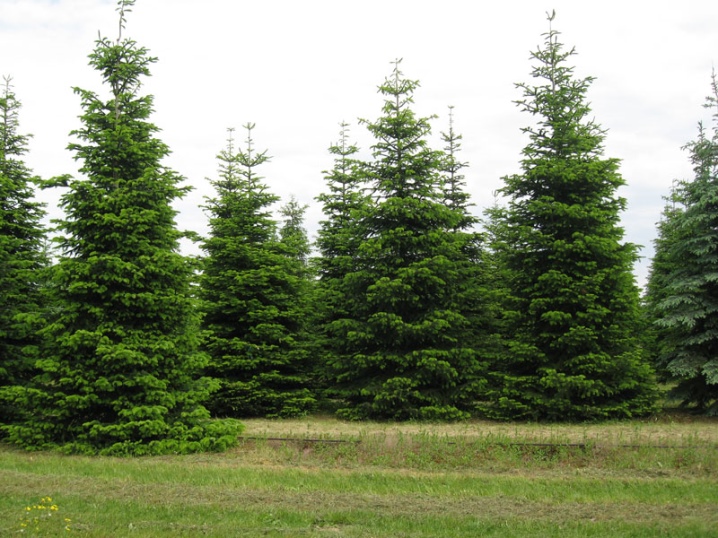
Picea abies is an evergreen species capable of reaching 30-50 m in height. The crown is conical or weeping, with drooping shoots. These spruce trees are characterized by a gray color of the bark, the needles are 1-2.5 cm long, the cones are pointed, oblong, brown.

Among the popular decorative forms of European spruce, one can distinguish grade "Tompa" Is a slow growing dwarf tree, an adult plant rarely exceeds 1 m in height. Creeping forms are also in demand, with "weeping" shoots - "Inversion", "Virgata"... Most of these species are represented only in nurseries and gardens of breeders.
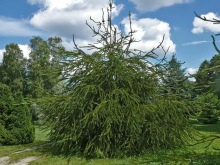
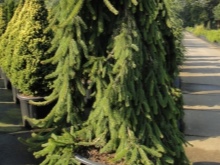
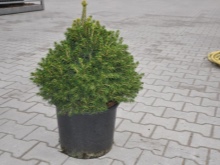
The main application of common spruce is landscaping of landscapes of cities and settlements, the creation of a snow-protective roadside in regions with a cold climate and heavy rainfall.
Korean
A species typical for the regions of the Far East, including North Korea and mountainous China. Outwardly, it reveals a significant similarity with Siberian spruce. In the Amur region, these conifers form whole forests, in China and Korea they are found mainly in river valleys and on mountain slopes at an altitude of up to 1800 m. The tree grows in a mild, humid climate, shade-resistant. Picea koreianesis Nakai was singled out as a separate species in 1919, thanks to the efforts of a Japanese botanist researcher named Nakai.
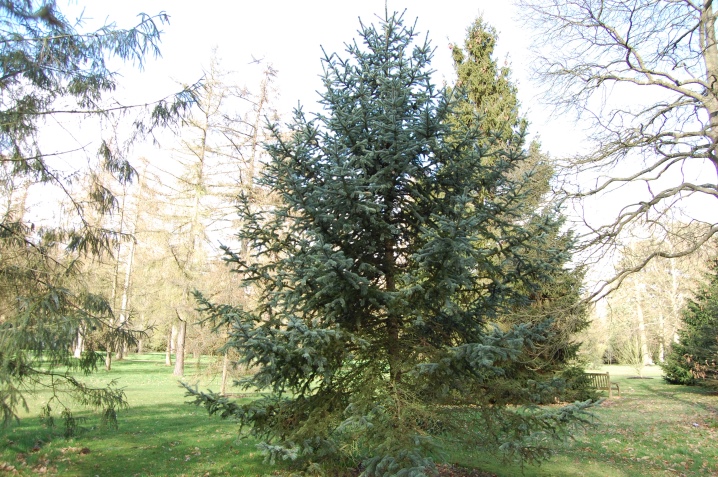
Korean spruce has a gray or gray-brown color of the trunk, young shoots are red-yellow with an ocher tinge, gradually darken, not covered with needles. The color of the needles is predominantly green, with a bluish tint. This form is characterized by a drooping crown type, the branches are lowered, and not located parallel to each other. The maximum trunk height is, according to various sources, 30-40 m.

Sitkhinskaya
This type of spruce has been known since the middle of the 19th century, its main habitat is the coastal zone of western North America from California to Alaska, it can be found at an altitude of up to 1000 m above sea level. The plant is found on mountain slopes, framing river flow areas and is generally considered very moisture-loving, can withstand periodic root flooding.
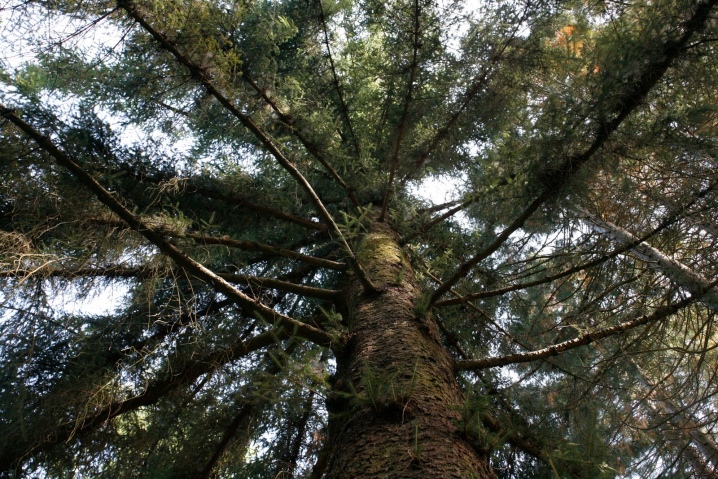
As part of the massifs, it can grow together with sequoia, alder and large-leaved maple, as well as conifers characteristic of the North American continent.
Pisea sitchensis is a tall tree capable of reaching 45-96 m in height, trunk diameter varies in the range of 120-480 cm. Young shoots are glabrous, light brown in color, the bark has a characteristic surface cracking, pronounced scaly, gray color, inclusions of a brown-brown shade are allowed. The needles of the tree are thin, flat, with pointed ends, green at the base and silvery at the tips.
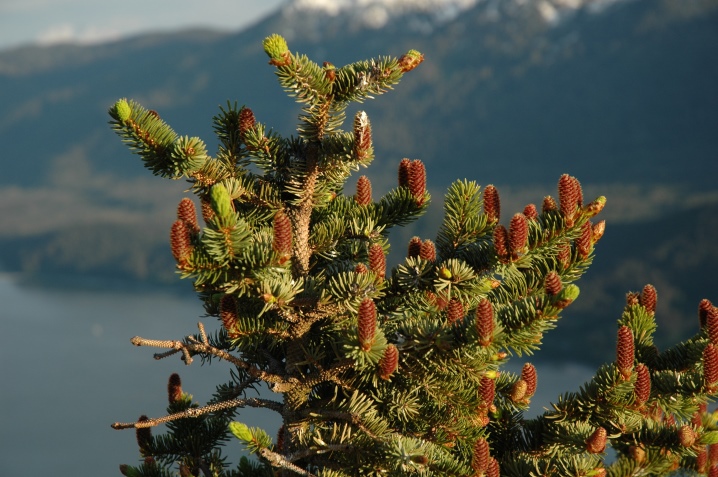
The Sitka spruce is characterized by a wide-pyramidal type of crown, thanks to which it acquires a special decorative effect. When planting in landscape design, it is used as a tapeworm or in groups of low density.
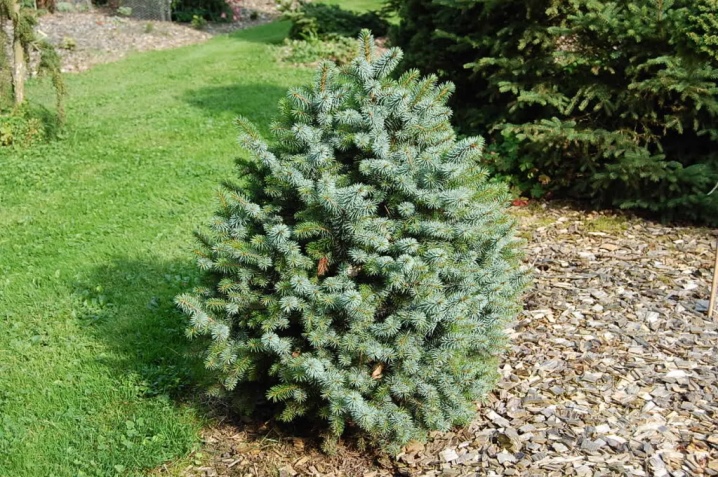
Eastern
Growing in northern Turkey and in the Caucasus mountains, Picea orientalis is protected as an endangered species, and today it is found mainly on the territory of reserves. Natural habitat is located at an altitude of 1345-2130 m above sea level. The species has been cultivated since 1837.In the northwestern climate of Russia, the tree demonstrates an extremely low growth rate - about 1 m in 20 years, does not tolerate frost well, but can be used as a decorative garden decoration.
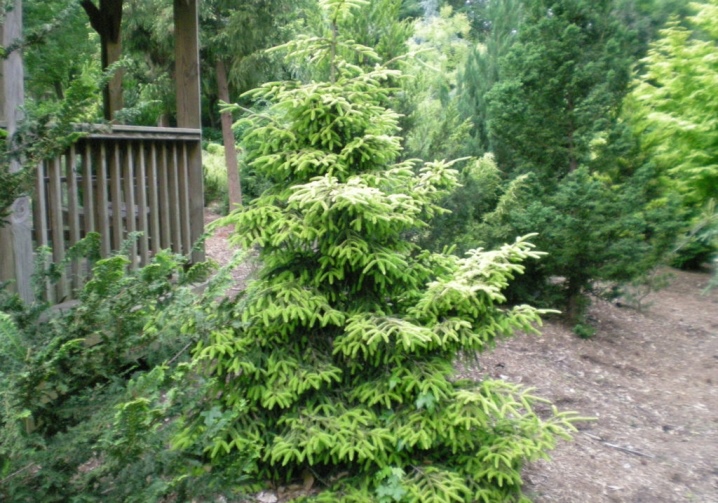
In nature, oriental spruce grows up to 32-55 m, forms a conical crown with whorled branches. The bark with a scaly structure, brown in young plants, acquires a dark gray tint in adults. The shoots are first reddish or yellow-gray in color, later they turn gray. The needles are short, no more than 10 mm long.
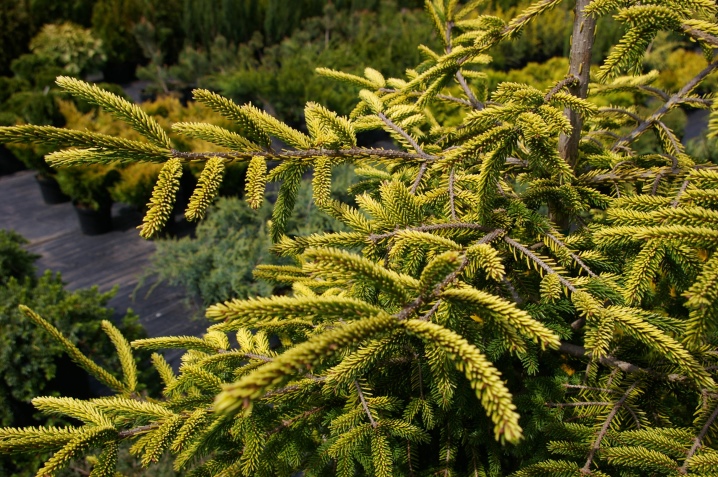
Prickly
The name "prickly spruce" hides the Picea pungens tree with decorative blue needles. In nature, the area of its growth is located in the western United States. Spruce is found in the states of Utah and Idaho, in Colorado and New Mexico, in mountainous regions, at an altitude of up to 3000 m above sea level. The plant is hygrophilous, prefers to grow on the banks of rivers and streams, providing sufficient moisture saturation of the roots.
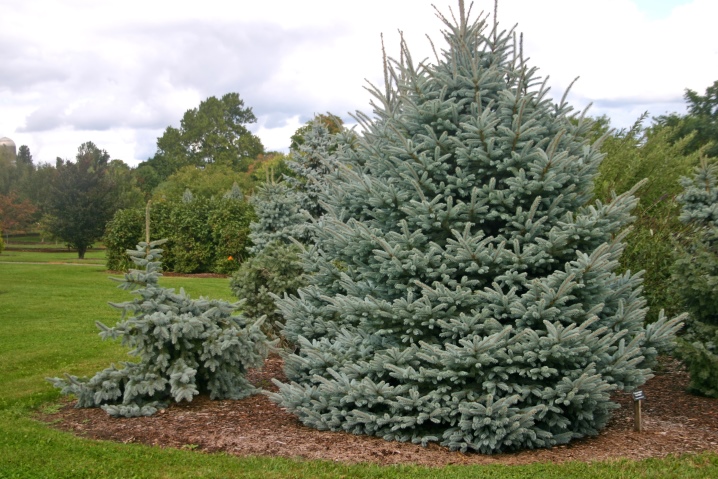
The species has been assigned a conservation status, but with low indicators of the threat of extinction.
In the conditions of central Russia, blue, or prickly, spruce rarely reaches significant sizes and is most often used as part of decorative plantings. In the USA, it grows up to 25-45 m with a trunk diameter of up to 150 cm. Young trees have a crown in the form of a narrow cone; over time, it becomes cylindrical. The needles are diamond-shaped, rather long - from 1.5 to 3 cm, the needles are painted in shades of gray-green and blue.
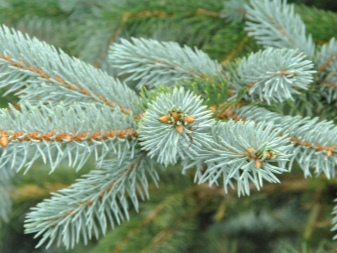
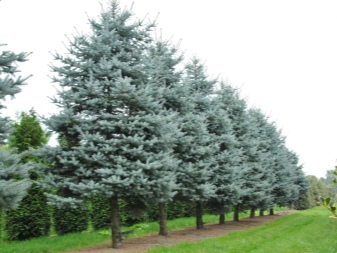
Glauka or white
Picea glauca is a type of North American spruce with an unusual bluish shade of needles. They are grown mainly as a decorative decoration of the landscape, they reach an average height of 15-20 m, but under favorable conditions they can demonstrate twice as high. The crown changes with age - from a narrow cone to a cylinder, the trunk diameter does not exceed 1 m. The needles have a diamond-shaped cross-section, rather long - up to 2 cm, colored blue-green at the base, and acquire a blue-white tint to the tip.
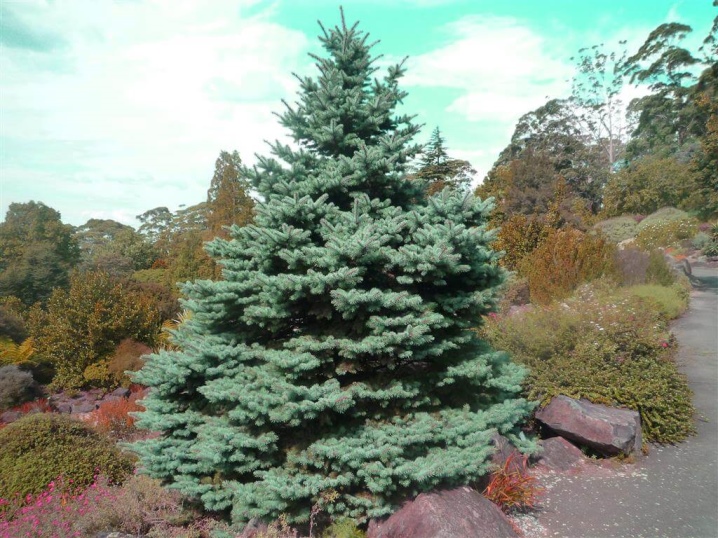
White spruce is found in the climatic zones of Alaska and the island of Newfoundland, in the forest-tundra zone of the northern states of the United States, in the Canadian provinces. Glauca is popular in landscape design due to its decorative appearance and good adaptability. A tree in a dwarf form can serve as the basis for rockeries and rock gardens.
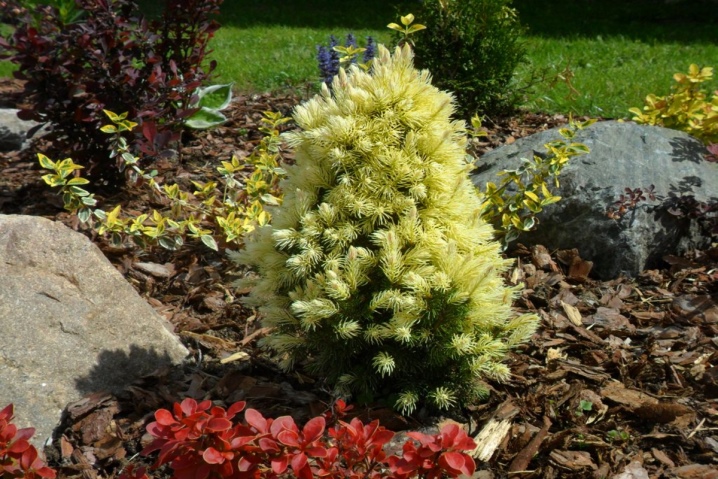
Glauka spruce tolerates drought, wind well, and is adapted to growing on nutrient-poor clay and stony soils.
Black
Picea mariana, or Pisea nigra, is a type of spruce typical of North America, but common in northern Europe as well as in Russia. The tree has a dwarf shape, growing to a height of no more than 50 cm. Adult plants of black spruce reach 7-15 m, the trunk thickness reaches 50 cm. They are characterized by a dark, gray-brown color of the bark, a small length of needles - from 6 to 15 mm, its shade is green or blue-green. The buds can vary in tone from purple to ocher red.

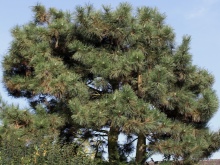
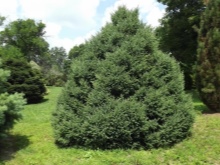
The ability of Picea nigra to form hybrids with other North American species is interesting - with Picea glauca, Picea rubens. Black spruce is one of the most common species in the United States. It can be found in the highlands of New York State, Appalachian Mountains, Michigan and Minnesota. It can form continuous spruce forests, part of the mixed forests of the taiga and forest-tundra.
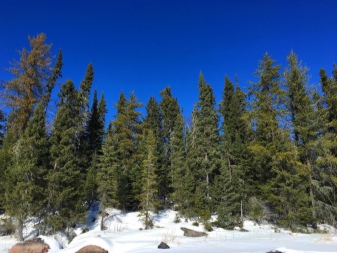

Trees of this species are not sensitive to the type of soil - they are adapted to the conditions of wetlands, permafrost, lowlands with high humidity.
Serbian
A popular cultivated species of spruce, which in the wild has an endangered status. Picea omorika has been known since 1875, it got its name in Serbia, where it grows, it was also preserved in Latin. In nature, the tree is found in the east of Bosnia and Herzegovina, in a river valley, at an altitude of 800-1600 m. The total area of the massif is 60 hectares; it is not represented anywhere else.
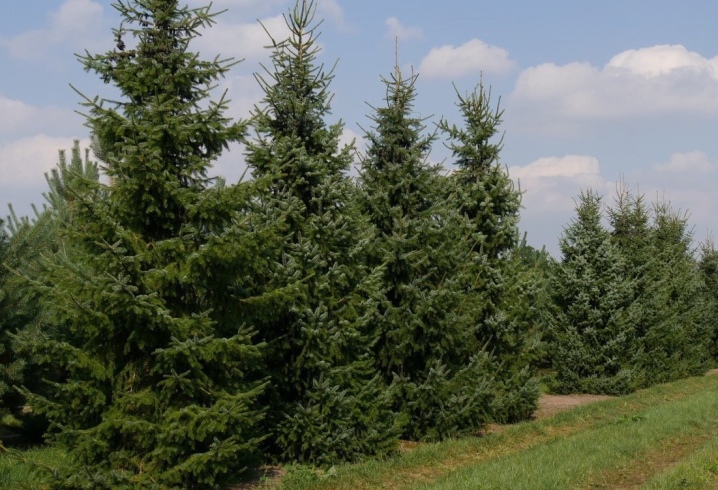
Serbian spruce is an evergreen tree with a trunk height of 20-40 m and a diameter of up to 1 m. The crown resembles a column in shape, in young plants it is closer to a narrow pyramid. The branches are short enough, far apart, directed slightly upward. The shoots are well pubescent, the needles are up to 20 mm long with a color transition from blue-green at the base to white-blue at the tips (according to other sources, the needles have a green tint).
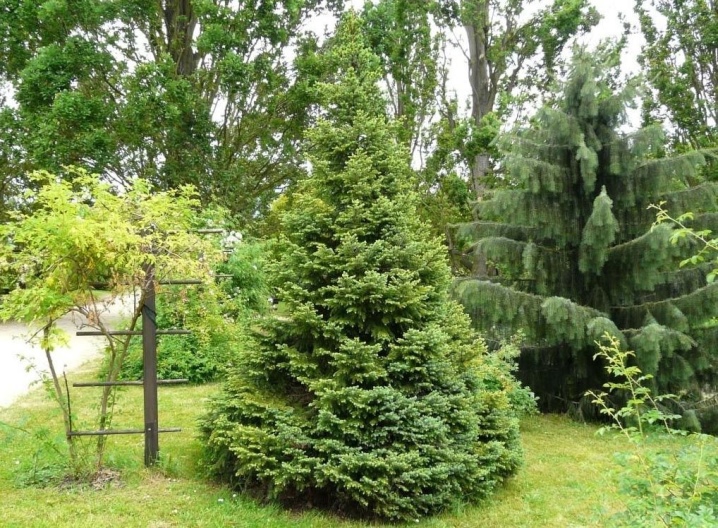
As a landscape decoration plant, Serbian spruce is very popular in the United States and Europe. It is appreciated for its attractive, decorative crown, high adaptive abilities, and general unpretentiousness.

The tree has a fairly high winter hardiness, it can grow in conditions of high gas pollution of the environment.
Schrenck
Shrenka spruce is a species found in the mountainous regions of Central Asia. It is typical for Kyrgyzstan, China, Kazakhstan and northern regions of Tajikistan. A widespread subspecies - the Tien Shan spruce, is found only in the Tien Shan and Alatau mountains. It can be found at an altitude of up to 3600 m above sea level. In landscaping, these trees are used to create parks - outside the natural environment, they have a lower height.

Picea schrenkiana has a crown in the form of a narrow pyramid or an elongated cylinder. The height of the trunk can reach 60 m, in diameter it can grow up to 200 cm. The bark of the tree has a flaky structure, rich brown color, needles of a diamond-shaped section, shoots are well pubescent.
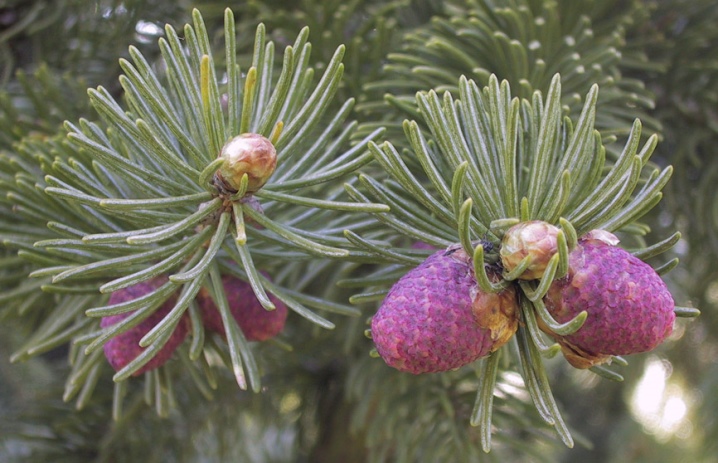
Other
Other popular species include the Wilson spruce, found exclusively in China. The plant belongs to the alpine, it is found at an altitude of 1400 to 3000 above sea level. It needs a mild continental climate and forms communities with Pisea asperata, Picea meyeri.

Popular in landscape design and another plant endemic to China - the Purple spruce. It is often used in mixed plantings. Another Asian tree is also interesting - Picea polita, which grows exclusively in Japan, on volcanic soils and mountain slopes. It prefers a humid climate and has rather thorny needles.

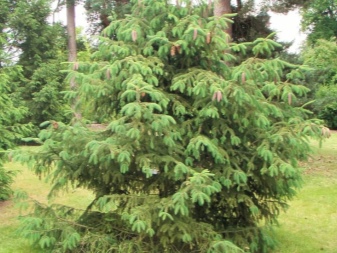
Alcocca spruce, also called bicolor, is also of great interest. It is found in Japan, in the highlands, is characterized by spreading branches and sensitivity to the choice of climatic zone for cultivation.

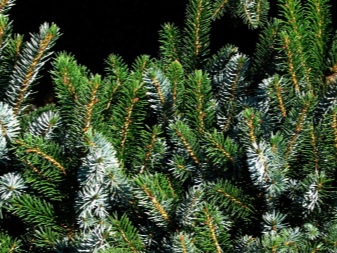
The Brevera spruce is a beautiful tree with weeping shoots. The trunk usually reaches 10-15 m, less often 20 m in height, it is characterized by a slow growth rate, no more than 10 cm per year. The view is well suited for landscape design, very decorative due to the long needles and hanging branches.

It is planted in open areas with enough sun.
Spruce hybrids
Trees of different species can form hybrid forms with other plants. As part of breeding work, this allows you to get more stable variants or emphasize decorative characteristics. One of the most popular spruce hybrids is called Picea mariorika. It was obtained as a result of crossing the black and Serbian species, has an interesting, wide-gled crown, bluish-green short needles. There is a decorative dwarf form Picea x mariorika Compacta, which grows no more than 50 cm in height and up to 1 m in diameter.
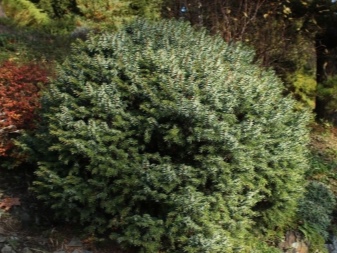
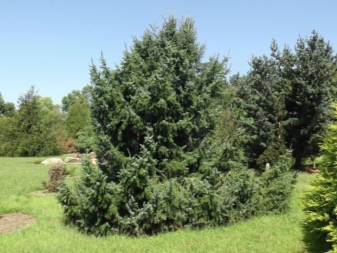
Another popular hybrid species is called "Finnish spruce". It originated by natural crossing of Picea abies and Picea obovata, European and Siberian varieties. In appearance, the tree is closest to the form growing in Siberia.
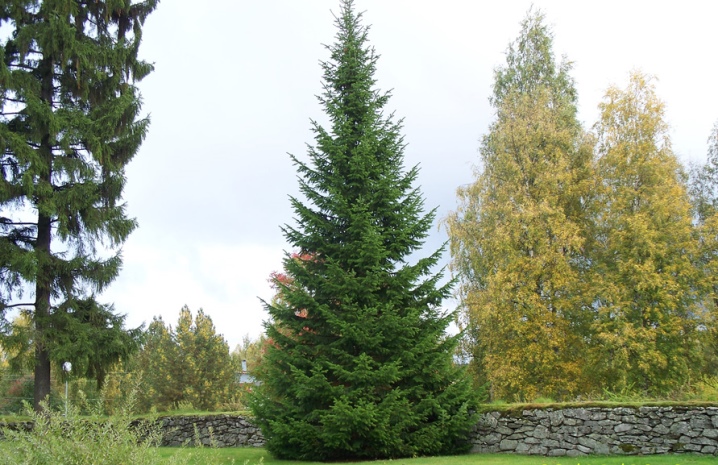
The species is also common in Russia.
Varieties of varieties with a description
The variety of varieties of spruce also gives a lot of scope for choosing ornamental plants that can decorate any garden. There are beautiful forms with red cones, blue, silver variants with unusual color of needles. Most often they are subdivided by height or crown shape. Among the most interesting and expressive options are the following.
"Kupressina"
A variety of ordinary spruce that grows up to 12 m in height. The tree has a dense conical crown, short needles.Cones change color from pink to reddish-brown, adding attractiveness to the plant. The variety is optimal for planting in massifs, withstands significant wind or snow loads, but is sensitive to gas pollution.
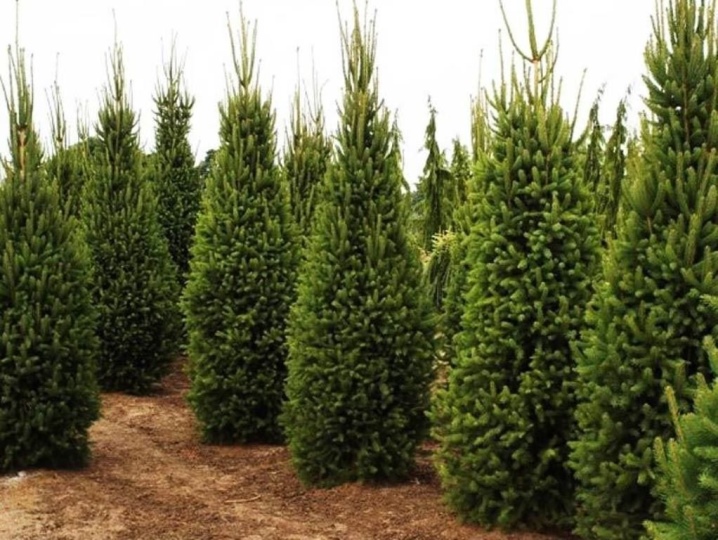
Spruce "Kupressina" is well suited for solitary planting, can be used as part of a screening barrier at the border of the site.
Oldenburg
A variety of blue spruces with a special decorative effect. The tree with a dense conical crown reaches 15 m in height, is characterized by high growth rates. Long, unusually colored needles of a silvery-gray shade will come to him especially attractive. The variety is suitable for wintering in the conditions of the Central Russian climatic zone, looks good in large gardens or as an element of the urban landscape.
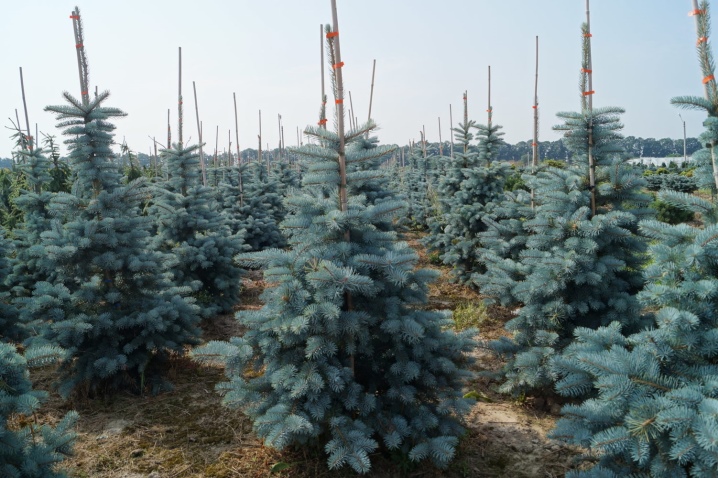
"Kruenta"
A very rare variety of common spruce, which grows up to 3 m in height. The plant has green needles with a reddish tint and a wide-pyramidal crown. It looks unusual thanks to the branches with red cones, which give a special decorative effect to spruce of any height.
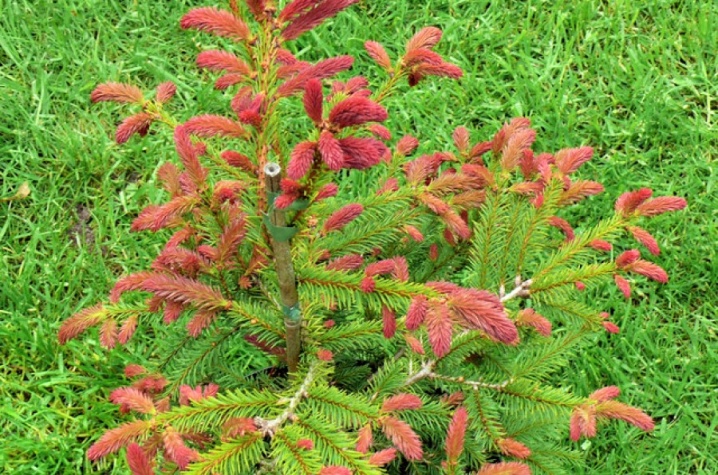
Young spring growths also have a bright crimson color.
"Wills Zwerg"
Popular cultivar Picea abies with a characteristic columnar crown shape. Refers to dwarf species, does not require complex care. Adult plants tolerate wintering well. By the age of 10, the spruce grows only up to 1 m, the maximum height is about 2 m, it is reached by the age of 30. In the spring, the tree looks especially decorative due to the young light green shoots.
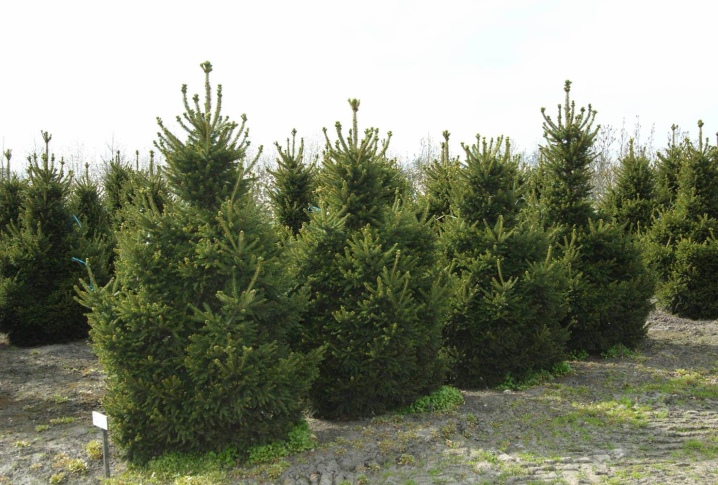
"Fastigiata"
A subspecies of prickly spruce, characteristic of the United States. The Isel Fastigiata variety has long silvery-blue needles; young trees have an imbalance between the width and length of the crown. The average size of a tree is about 3-4 m, in the wild it grows up to 12 m.
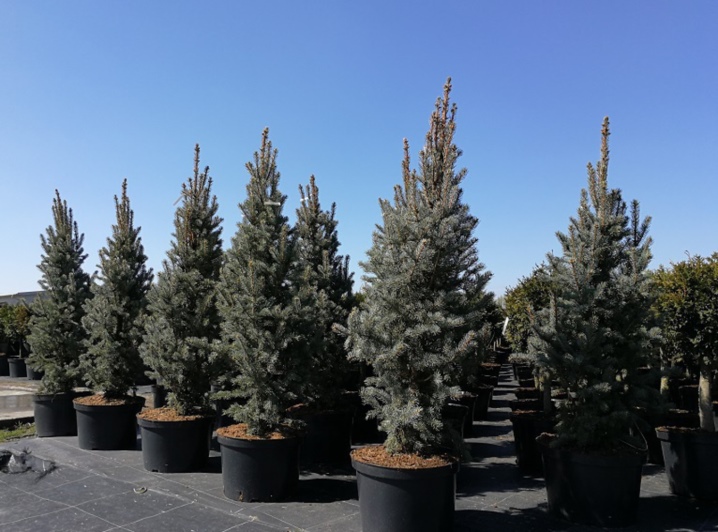
Thanks to its compact dense branches, the variety does not break under the weight of snow.
"Pygmy"
A compact dwarf variety of spruce with a crown up to 2-3 m wide and no more than 1 m high. The cone-shaped crown is quite dense, the branches are directed upward, the needles are short. "Pygmy" has a high decorative effect, it is placed in rock gardens and rockeries, as part of collectible gardens. The variety is characterized by high frost resistance.
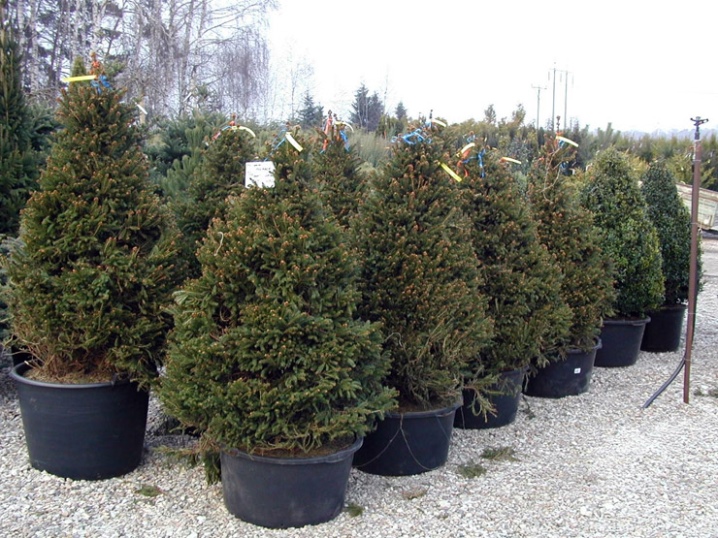
"Barry"
A variety of ordinary spruce, belonging to the slow-growing dwarf forms. By the age of 30, the maximum height reaches 2 m, the branches are directed upwards, quite strong and strong. The needles have a bright green color, the tree is suitable for single and group plantings, the crown can be formed in the form of a cone, spiral, ball.
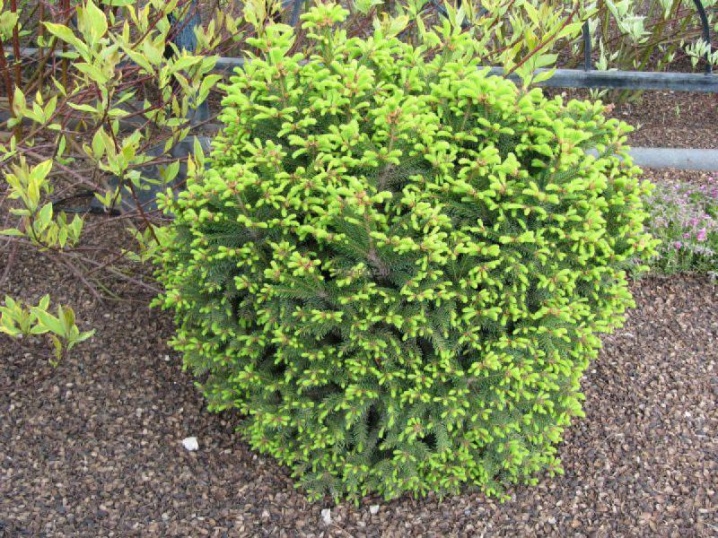
"Aureospicata"
Eastern spruce variety, bred by breeders from Germany. The tree, even in adulthood, does not exceed 10-15 m, has a loose, not too dense crown in the form of a pyramid. The lateral branches have a slightly hanging shape, a special decorative effect of the spruce is given by the growth of shoots of a juicy light green shade, which stands out against the background of dark needles, and the raspberry shade of the cones.
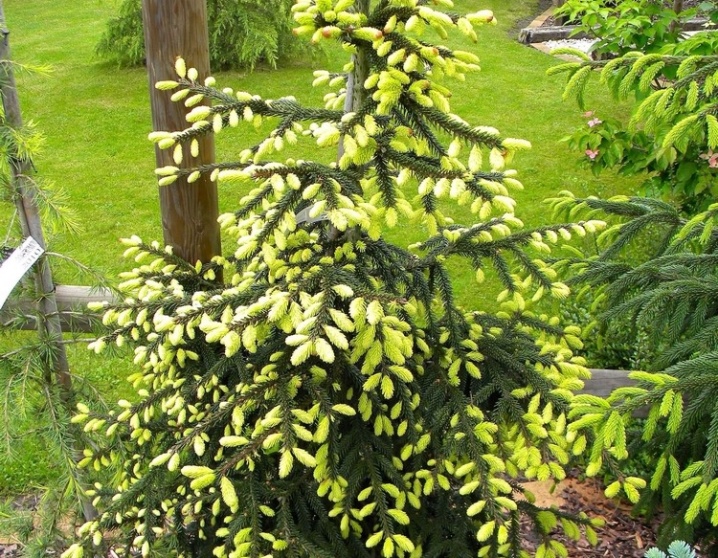
"Akrokrona"
A common spruce variety bred in Finland. It is characterized by a bright green color of needles with young shoots of a herbaceous shade, against which crimson-pink cones stand out, abundantly appearing on the branches. The variety is low, up to 4 meters high, with a lush wide-pyramidal crown - it reaches 3 m in diameter at the lowest point.

A very decorative option, suitable for compact gardens or single placement.
Olendorfi
A dwarf variety of the species Picea abies originated in Germany. By the age of 10, the tree grows up to 1-2 m, it is characterized by slow development with the addition of no more than 6 cm in height per year. The crown of considerable width, rounded in a young tree, as it grows, acquires a pyramidal shape with several tops. The needles are thin, light green, with a golden tint, the Olendorfi spruce is well suited for decorating rockeries, mixed planting.
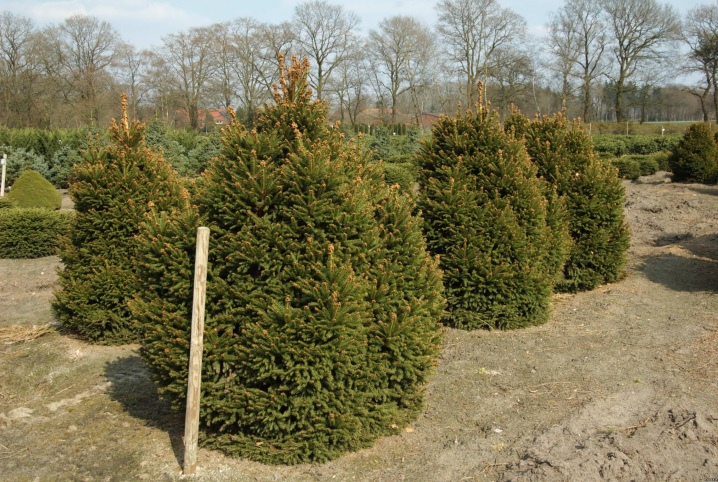
Froburg
An interesting weeping variety of ordinary spruce, has a conical shape, a straight trunk.It was bred in Switzerland, belongs to the medium-sized forms, reaching a height of 4 m by 10 years. Sloping shoots gradually form a crown with an unusual train, creeping along the ground, and raspberry-green cones.

Alberta Globe
Dwarf variety of Canadian spruce, with an interesting spherical crown shape. By the age of 10, the plant reaches 30 cm in diameter and height, the maximum size is 0.7-1 m. The needles are graceful, the branches are densely located, the lateral shoots are well developed. The variety is suitable for group plantings, rockeries decoration.
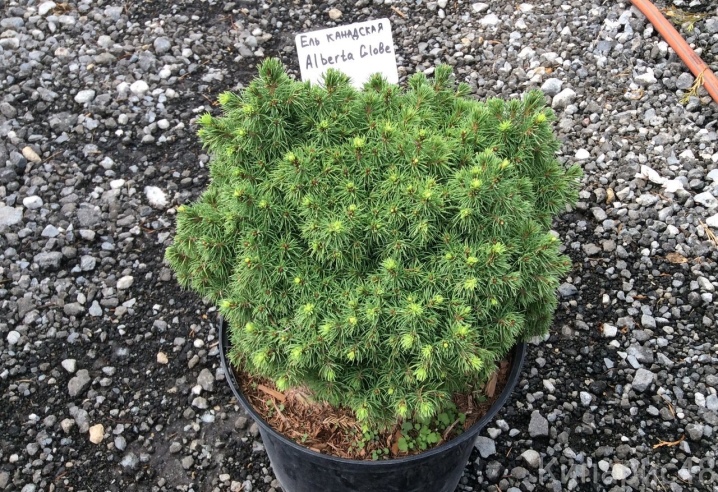
"Konika"
Another subspecies of Canadian or gray spruce, is one of the most popular varieties in landscape design. The tree grows slowly, reaches 2 m in height, the crown is dense, in the form of a regular cone. A distinctive feature of the variety is the absence of the need for decorative pruning. - the plant already perfectly retains its shape.

Needs protection from direct sunlight to prevent pine needles from burning out.
"Compact"
A dwarf variety of European spruce has a compact size and a neat conical crown. On average, it grows up to 2-3 m, has compact shoots, green needles with a pronounced shine. The variety is characterized by slow development, suitable for small areas.
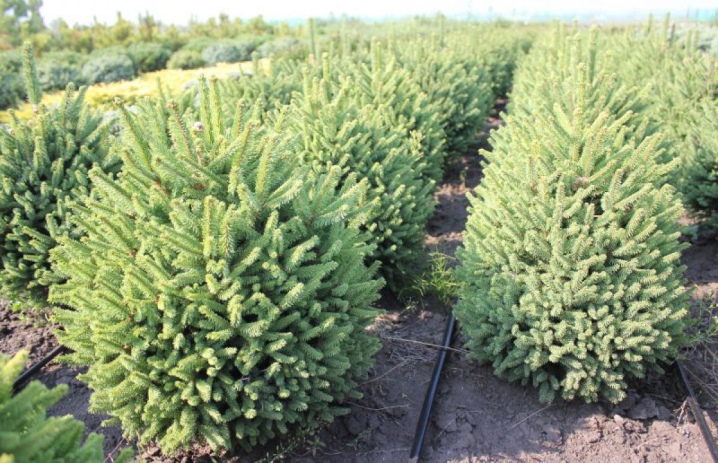
By height
When dividing varieties of spruce into groups, classification by height is usually used. The following groups are distinguished.
- Stunted. They are dwarf, with a compact, most often spherical spreading crown. These include the pillow-shaped Blue Pearl, the compact conical Lucky Strike, the sprawling Goblin and its related Nidiformis.
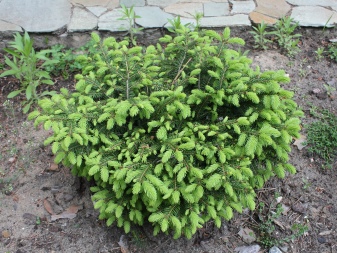
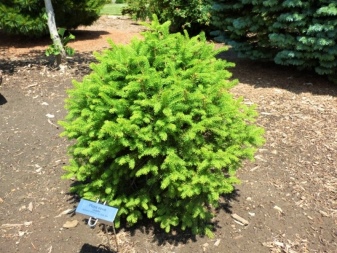
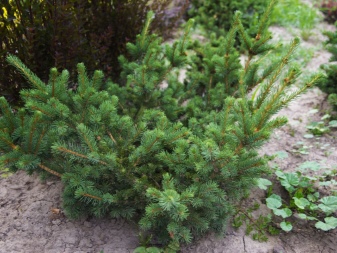
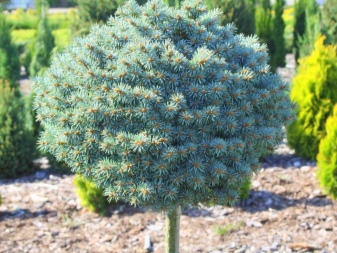
- Medium-sized. They are characterized by a height of up to 3 m or slightly higher. The average annual growth rarely reaches more than 10 cm. These include the already mentioned "Kruenta", spreading Pendula Bruns, "Christmas Blue" with the original blue and white color of the needles.

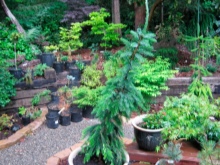
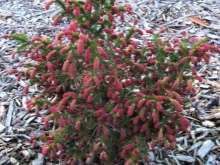
- Tall. They grow up to 10 m or more, differ in a conical or cylindrical crown shape. Among the most prominent representatives of this type are the varieties Iseli Fastigiata, Columnaris.


By form
If we consider the division of varieties of spruce according to the shape of the crown, the following options can be noted.
- Globular. It resembles the correct sphere, most often found in young trees, and changes with age. The spherical crown is popular in landscape design.
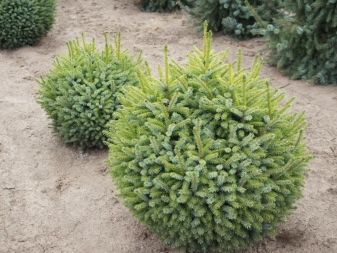

- Umbrella. Trees with a spherical crown grow into it. In this case, the crown remains domed at the top and wide at the base.
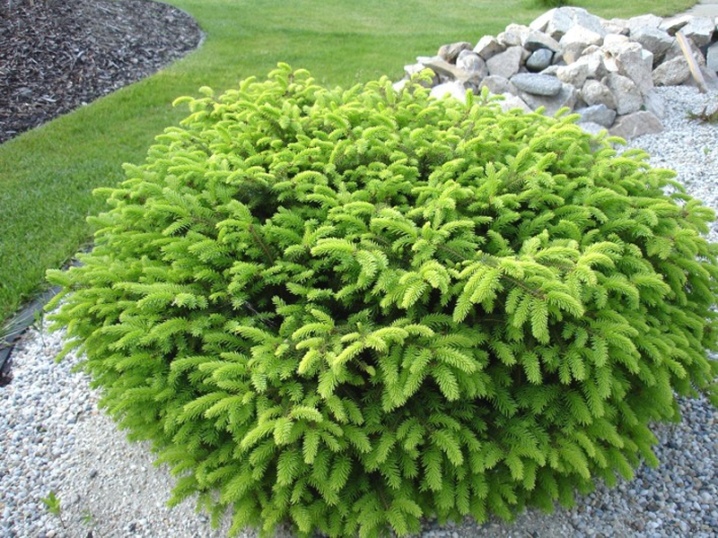
- Cushion-shaped. A spreading version of the crown, in which the ratio of width to length is 3: 2. One of the most effective shape options, easy to trim.


The cushion crown is found in adult dwarf spruces.
- Creeping. It is found in undersized varieties of weeping spruces. Lateral shoots are long, lying on the ground.
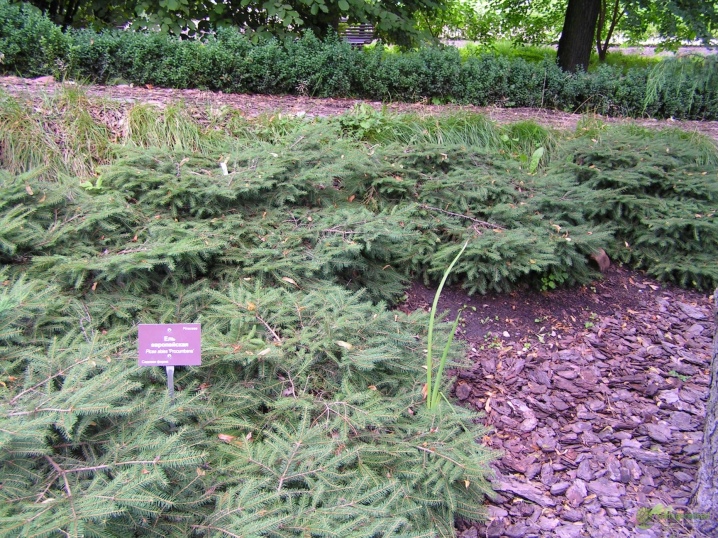
- Weeping. With branches pointing down. Can be combined with a narrow pyramidal shape.
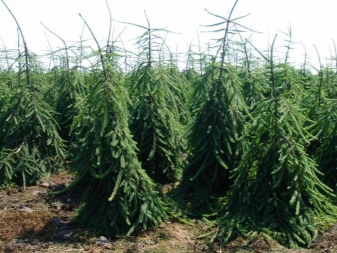
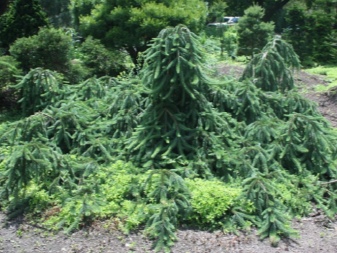
- Pyramidal. May have a sharp or blunt apex. There are narrow-pyramidal and wide-pyramidal species, in which the base diameter is equal to the height of the apex.
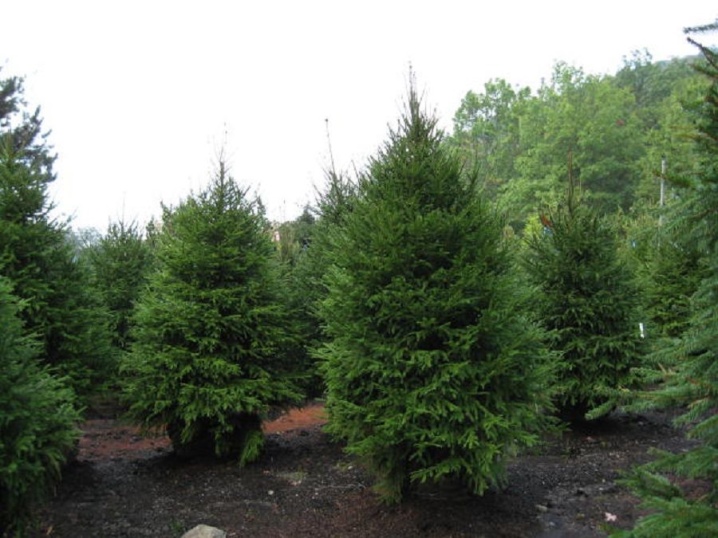
- Columnar. Found in decorative varieties of spruce. The branches are almost the same length along the entire height of the trunk.

- Serpentine. Typical for varieties with a deformed crown. Part of the original branch group.

How to choose?
When choosing the types and varieties of spruce for landscape design, it is important to take into account the features of the arrangement of the territory, the area of the site, the climatic compliance of the plant with the growing conditions. So, on an area of more than 12 acres, it is impractical to plant dwarf plant varieties. In a large manor house, you can decorate with such spruce only the driveways to the house or the lawn framing the facade.
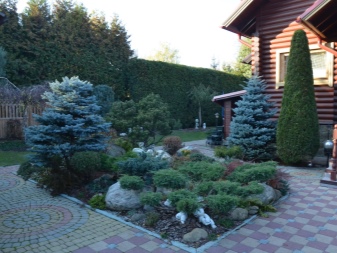

Dwarf varieties are well suited for a small summer cottage or personal plot, harmoniously combined with flowering crops.
Varieties up to 3-4 m in height are perfect for the formation of hedges on the border of the site. They grow well, provide protection from the wind and shade for plants that need it. The alleys of blue spruce trees and single plantings of such trees also look interesting. Large, tall trees with a pyramidal crown look good on a spacious plot.
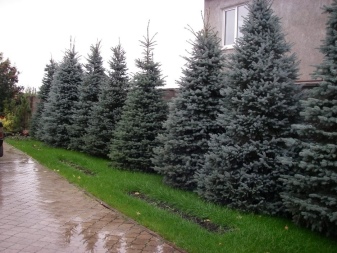

Advice
Growing spruce on the site requires compliance with certain rules.
- Careful timing for boarding. For blue varieties, this is only the spring period, the rest can be planted from April to June and from September to November.
- Selection of seedlings. Plants from 0.7 to 2 m in height (except for dwarf varieties), with a closed root system are considered the best option. In autumn, large plants are planted with a height of 3 m.
- Choosing a landing site. All conifers are sun-loving and need a lot of light. But some decorative varieties with too delicate needles need to be shaded so that they do not burn. When planted in strong shade, the tree will bare the trunk, the needles will be less bright.
- Preparation of soil mixture. For spruce trees, a composition based on 20% sand and humus, 30% peat and turf is considered ideal. The mixture is flavored with nitroammophos in the amount of 0.15 kg. If there is such a composition in the planting pit, further rooting of the tree will not cause trouble.
- Regular watering. Blue species need it less than others, they are drought tolerant. Sprinkling 3-4 times a week is shown for young plants in the heat. Watering as usual is done once every 14 days, 10 liters of water at the root. In the heat, it is performed weekly.
- Crown formation. Pruning is performed annually: sanitary pruning is performed in April, with the appearance of young shoots, and shaping is recommended at the end of the growing season, in the second half of summer.
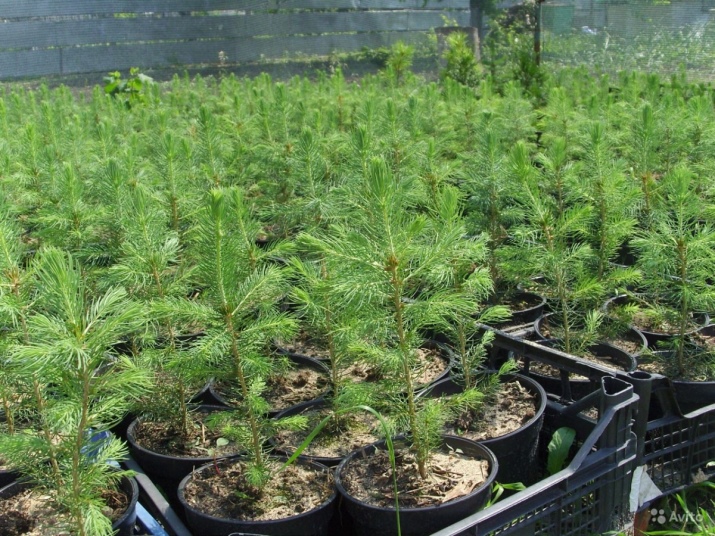
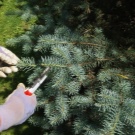
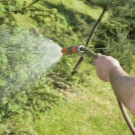
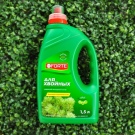
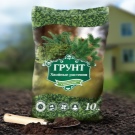
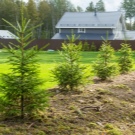
Following these recommendations, you can achieve good survival rate of spruce on the site. Beautiful and strong conifers will be a harmonious addition to the landscape of a spacious estate or summer cottage.
For information on how to choose spruce in the nursery, see the video below.



































































The comment was sent successfully.